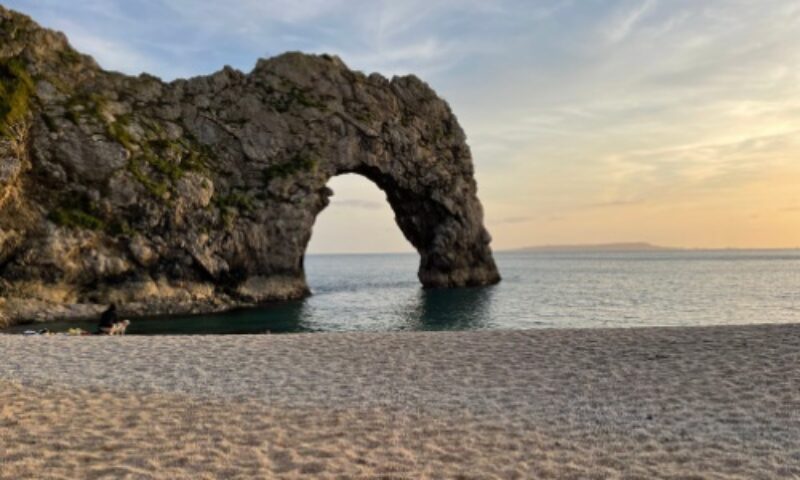As the weather starts to get warmer, you might be dreaming of a day at the beach.
Although we can’t guarantee sunshine in the UK this summer, we can promise that there is a beach to suit everyone’s needs.
Read on to discover nine of the best beaches in the UK.
Blue Flag beaches
These three beaches have all been awarded Blue Flag status, which means they passed the Foundation for Environmental Education’s stringent standards for water quality, safety, and environmental education.
1. Aberdour Silver Sands, Fife
One of the most popular and attractive sandy beaches on the Fife coast, Aberdour Silver Sands is a charming beach that looks out to the abbey on the islands of Inchmickery and Inchcolm.
If you are interested in a hike before settling on the beach, the Fife coastal path passes by Aberdour, making it a perfect pit stop. Lifeguards also patrol the beach from the start of July to the end of August, so you can relax knowing you are safe.
2. Blackpool South Beach, Lancashire
Blackpool is a classic beach destination, with its famous piers and plenty of attractions for families.
South Beach has excellent water quality and amazing amenities, with the Blackpool promenade right beside it if you want to pop into any amusements, restaurants, or shops.
3. Abersoch Beach, Gwynedd
This delightful Welsh beach is part of a gorgeous seaside resort that tends to attract sailing enthusiasts and people interested in watersports.
With both Blue Flag status and certification from the Marine Conservation Society, this sandy beach is a picturesque place to relax or ride the adrenaline high of a jet ski.
Hidden beaches
On sunny days, many of the popular beaches can be swamped by people trying to make the most of the nice weather.
These smaller and more discreet spots are perfect for anyone who wants to enjoy a beach without having to compete with bustling families, a lack of space, and extra noise.
4. Kynance Cove, Cornwall
As it is only two miles from popular Lizard Point, many people miss the turn-off to this dramatic location.
The white sandy beaches are bracketed by colourful 200ft cliffs, so you can spend your day exploring the stunning location or enjoying the sun without having to deal with any crowds.
5. White Park Bay, Northern Ireland
This glorious three-mile stretch of sand is tucked away in a secluded spot on the Giant’s Causeway – the first World Heritage Site in Northern Ireland.
Even on sweltering summer days, this beach is empty. Explore the ancient dunes, admire Elephant’s Rock, and remember to keep an eye out for the local dolphins and porpoises.
6. Steephill Cove, Isle of Wight
If you were planning on visiting busy Ventnor beach, head down the road to Steephill Cove instead.
Since the only way to access the cove is down a winding narrow path, there is no road noise, pesky crowds, or tourist shops to ruin the stunning view.
Best historical beaches
Some of the UK’s beaches also come with a fascinating history. These spots are for you if you are interested in delving into the stories behind the destinations you visit.
7. Durdle Door, Dorset
In 2001, the Jurassic Coast became the UK’s first UNESCO World Heritage Site.
The famous limestone arch from which Durdle Door gets its name is one of the UK’s most iconic landmarks. Hunt for fossils and relax on the golden sands, and feel free to bring your four-legged friend as this beach is dog-friendly.
8. Albion Sands, Pembrokeshire
This secluded sandy beach is just west of the better-known Marloes Sands and has the same abundance of wildlife and fascinating geology.
However, the interesting story behind the beach’s name goes back to a shipwrecked paddle steamer from 1837, which crashed on the beach while carrying enough whisky from Dublin to keep Pembrokeshire drunk for a year.
If you visit at low tide, you can even see the Albion’s shaft protruding from the sand.
9. Abbot’s Cliff, Folkestone Kent
This pebbly seashore sits just below gorgeous white cliffs but is most well-known for its acoustic sound mirror, which was built in 1928 to listen out to sea for enemy aircraft.
The beach was damaged during the 77 air raids and 6 V1, which hit it during World War Two. But its history goes back even further, as the chalk from Abbot’s Cliff was used to build the local Roman Villa that was excavated in 1924.

